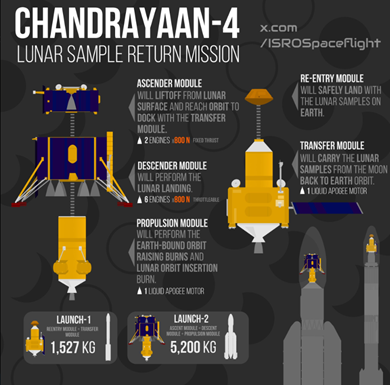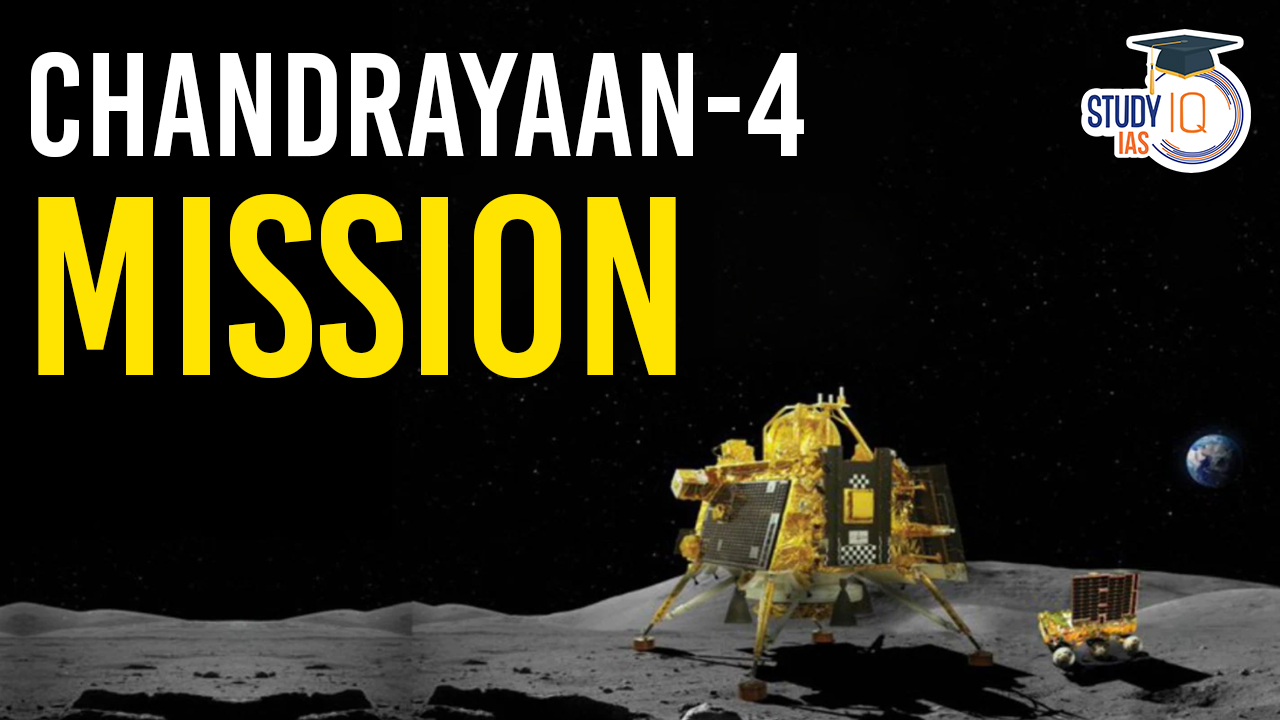Table of Contents
Context: According to ISRO, a series of space-docking experiments will be conducted before the launch of the Chandrayaan-4 mission.
Chandrayaan-4 Mission
- Mission Objective: It aims to bring rock and soil samples back from the Moon.
- Modules: The Chandrayaan-4 spacecraft will consist of 5 modules, unlike Chandrayaan-3, which had 3.
- Ascender Module (AM): To Collect and transfer samples.
- Descender Module (DM): To Facilitate landing and sample collection.
- Re-entry Module (RM): Safely returns samples to Earth.
- Transfer Module (TM): It will enable module docking and transfer.
- Propulsion Module (PM): To power maneuvers.
- Landing and Sample Collection: Two modules will detach from the main spacecraft, land on the Moon and collect samples.
- One of these will then launch itself back to the main spacecraft in lunar orbit, where the samples will be transferred.
- Sample Return: The samples will be moved to an Earth re-entry vehicle, launched separately, which will return the samples to Earth.
- Docking Operations: The mission will involve docking space modules twice, introducing a new capability for ISRO that will be first tested in the already launched Spadex mission.

ISRO to Launch Two Rockets for Chandrayaan-4 Moon Mission
India’s Chandrayaan-4 mission, set for a historic launch no earlier than 2028, will utilize two rockets, LVM-3 and PSLV, to retrieve lunar rocks and soil for scientific study. Representing ISRO’s first dual-rocket mission, Chandrayaan-4 underscores India’s advancements in space exploration.
The Chandrayaan-4 Moon Mission, comprising five spacecraft modules, aims to collect samples from the moon’s surface, showcasing India’s growing prowess in lunar research. This milestone endeavour positions India as the fourth nation capable of executing lunar sample return missions, marking a significant achievement in the country’s space exploration endeavours.
Chandrayaan-4 Mission Details
The Indian Space Research Organisation (ISRO) and the Japan Aerospace Exploration Agency (JAXA) are planning a collaborative lunar mission called the Lunar Polar Exploration Mission (LUPEX), also known as Chandrayaan-4. No sooner than 2026, the project would send an unmanned lunar lander and rover to investigate the area around the Moon’s south pole. The rover and the H3 launch vehicle, which is still under construction, are likely to be provided by JAXA, but the lander would be supplied by ISRO.
| Chandrayaan-4 Mission Details | |
| Particular | Details |
| Mission type | Lander and Rover |
| Mission is under | ISRO and JAXA |
| Mission Duration | 6 months |
| Manufacturers |
|
| Landing Site | South Pole Region of the Moon |
| Payload Mass | 350 Kg |
| Launch Site | Tanegashima, Japan |
| Rocket | H3 Launch Vehicle |
Background of Chandrayaan-4 Mission
To explore the polar regions of the Moon for water with a joint Lunar Polar Exploration Mission (LUPEX) that would be launched no earlier than 2025, ISRO and Japan Aerospace Exploration Agency (JAXA) signed an Implementation Arrangement (IA) in December 2017 for pre-phase A, phase A study, and completed the feasibility report in March 2018.
In December 2018, ISRO and JAXA performed the Joint Mission Definition Review (JMDR). 2019 will see the completion of JAXA’s internal Project Readiness Review. India began researching a new lunar mission called Chandrayaan-3 as a follow-up attempt to show the landing capabilities required for the LUPEX after Chandrayaan-2’s lander crashed on the Moon during its landing attempt in September 2019.
Early in 2021, JAXA completed its domestic System Requirement Review (SRR). LUPEX Working Group 1 landed in India in April 2023 intending to exchange information about command and telemetry ground antennas, methodologies for predicting the positions of landers and rovers on the moon, and landing site analysis on promising prospective sites.
Objective of Chandrayaan-4 Mission
The primary goal of the Chandrayaan-4 Mission is to provide a solution to one of lunar exploration’s most intriguing mysteries: whether or not the moon, Earth’s natural satellite, has water. The Chandrayaan-4 Mission’s main goal is to examine the lunar poles for the presence of water and its possible utility. These goals will be accomplished by the mission through two essential methods, which include figuring out how much and what kind of water is available on the moon.
The India-Japan collaborative mission makes use of the strengths of both countries to advance knowledge of lunar explorations and to provide an answer to one of the most significant and fascinating problems in lunar science.
Two Aspects of Chandrayaan-4 Mission
- Based on the current observational data, the Quantity Aspect aims to determine the actual amount of water in the projected areas. by gathering the ground truth information and in-situ measurements. The LUPEX will provide a crucial baseline for determining how much water can be obtained locally and how much has to be brought from Earth for upcoming lunar missions. The sustainability and economics of lunar exploration will change due to this data.
- The Quality Aspect uses in-situ observations in the polar regions of the moon to understand the distribution, circumstances, and shape of lunar water resources. To use lunar water for support, propulsion, or shielding, it is essential to comprehend these factors.
How Chandryaan-4 Mission will achieve its Objective?
The LUPEX will launch a cutting-edge spacecraft with thin-film solar cells and ultra-high-density energy storage to accomplish these goals. This will guarantee a continuous power supply even during lunar nights and in darkened places. The rover’s mobility and survivability in the lunar environment depend on this technological advancement.
The goal of LUPEX is to develop the science needed for surface investigation on low-gravity celestial planets. This includes finding ways to move around, perfecting systems for surviving the lunar night, and creating excavation methods for future mining operations. Future lunar activities will benefit from these technical developments, and they may also have an impact on trips to Mars and beyond.
| Related Concepts |
|


 Genome India Project (GIP), Aim and Sign...
Genome India Project (GIP), Aim and Sign...
 Biomass Satellite, Key Objectives and Pa...
Biomass Satellite, Key Objectives and Pa...
 Laser Weapon System, Advantages and Asso...
Laser Weapon System, Advantages and Asso...





















